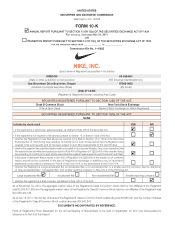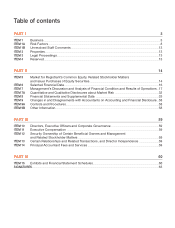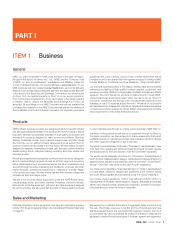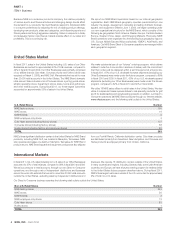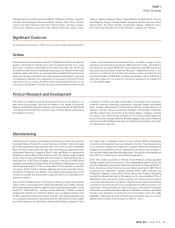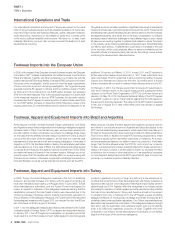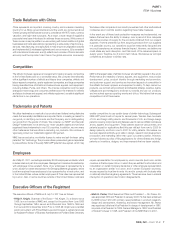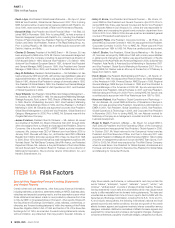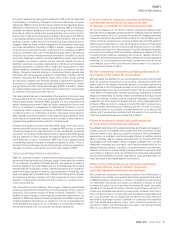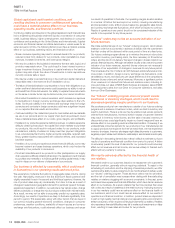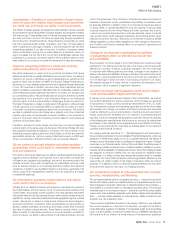Nike 2011 Annual Report Download - page 7
Download and view the complete annual report
Please find page 7 of the 2011 Nike annual report below. You can navigate through the pages in the report by either clicking on the pages listed below, or by using the keyword search tool below to find specific information within the annual report.
7NIKE,INC.-Form10-K
PARTI
ITEM1Business
Trade Relations with China
China represents an important sourcing country and consumer marketing
country for us. Many governments around the world are concerned about
China’s growing and fast-paced economy, compliance with WTO rules, currency
valuation, and high trade surpluses. As a result, a wide range of legislative
proposals have been introduced to address these concerns. While some of
these concerns may be justifi ed, we are working with broad coalitions of global
businesses and trade associations representing a wide variety of sectors (e.g.,
services, manufacturing, and agriculture) to help ensure any legislation enacted
and implemented (i)addresses legitimate and core concerns, (ii)is consistent
with international trade rules, and (iii)refl ects and considers China’s domestic
economy and the important role it has in the global economic community.
Webelieve other companies in our industry as well as most other multi-national
companies are in a similar position regarding these trade measures.
In the event any of these trade protection measures are implemented, we
believe that we have the ability to develop, over a period of time, adequate
alternative sources of supply for the products obtained from our present
suppliers.If events prevented us from acquiring products from our suppliers
in a particular country, our operations could be temporarily disrupted and
we could experience an adverse fi nancial impact. However, we believe we
could abate any such disruption, and that much of the adverse impact on
supply would, therefore, be of a short-term nature. We believe our principal
competitors are subject to similar risks.
Competition
The athletic footwear, apparel, and equipment industry is keenly competitive
in the UnitedStates and on a worldwide basis. We compete internationally
with a signifi cant number of athletic and leisure shoe companies, athletic and
leisure apparel companies, sports equipment companies, and large companies
having diversifi ed lines of athletic and leisure shoes, apparel, and equipment,
including Adidas, Puma, and others. The intense competition and the rapid
changes in technology and consumer preferences in the markets for athletic
and leisure footwear and apparel, and athletic equipment, constitute signifi cant
risk factors in our operations.
NIKE is the largest seller of athletic footwear and athletic apparel in the world.
Performance and reliability of shoes, apparel, and equipment, new product
development, price, product identity through marketing and promotion,
and customer support and service are important aspects of competition in
the athletic footwear, apparel, and equipment industry. To help market our
products, we contract with prominent and infl uential athletes, coaches, teams,
colleges and sports leagues to endorse our brands and use our products,
and we actively sponsor sporting events and clinics. We believe that we are
competitive in all of these areas.
Trademarks and Patents
We utilize trademarks on nearly all of our products and believe having distinctive
marks that are readily identifi able is an important factor in creating a market for
our goods, in identifying our brands and the Company, and in distinguishing
our goods from the goods of others. We consider our NIKE® and Swoosh
Design
®
trademarks to be among our most valuable assets and we have
registered these trademarks in over 150 countries. In addition, we own many
other trademarks that we utilize in marketing our products. We continue to
vigorously protect our trademarks against infringement.
NIKE has an exclusive, worldwide license to make and sell footwear using
patented “Air” technology. The process utilizes pressurized gas encapsulated
in polyurethane. Some of the early NIKE AIR® patents have expired, which may
enable competitors to use certain types of similar technology. Subsequent
NIKE AIR® patents will not expire for severalyears. We also have hundreds
of U.S. and foreign utility patents, andthousands of U.S. and foreign design
patents covering components and features used in various athletic and leisure
shoes, apparel, and equipment. These patents expire at various times, and
patents issued for applications fi led thisyear will last from now to 2025 for
design patents, and from now to 2031 for utility patents. We believe our
success depends primarily upon skills in design, research and development,
production, and marketing rather than upon our patent position. However,
we have followed a policy of fi ling applications for UnitedStates and foreign
patents on inventions, designs, and improvements that we deem valuable.
Employees
As of May31,2011, we had approximately 38,000 employees worldwide, which
includes retail and part-time employees. Management considers its relationship
with employees to be excellent. None of our employees is represented by a
union, except for certain employees in the Emerging Markets geography, where
local law requires those employees to be represented by a trade union, and
in the UnitedStates, where certain employees of Cole Haan are represented
by a union. Also, in some countries outside of the UnitedStates, local laws
require representation for employees by works councils (such as in certain
countries in the European Union, in which they are entitled to information and
consultation on certain Company decisions) or other employee representation
by an organization similar to a union, and in certain European countries,
weare required by local law to enter into and/or comply with (industry wide
or national) collective bargaining agreements. There has never been a material
interruption of operations due to labor disagreements.
Executive Offi cers of the Registrant
The executive offi cers of NIKE as of July14,2011 are as follows:
•
Philip H. Knight, Chairman of the Board— Mr.Knight, 73, a director since
1968, is a co-founder of NIKE and, except for the period from June1983
through September1984, served as its President from 1968 to 1990 and
from June2000 to December2004. Prior to 1968, Mr.Knight was a certifi ed
public accountant with Price Waterhouse and Coopers& Lybrand and was
an Assistant Professor of Business Administration at Portland State University.
•
Mark G. Parker, Chief Executive Offi cer and President— Mr.Parker, 55,
was appointed CEO and President in January2006. He has been employed
by NIKE since 1979 with primary responsibilities in product research,
design and development, marketing, and brand management. Mr.Parker
was appointed divisional VicePresident in charge of development in 1987,
corporate Vice President in 1989, General Manager in 1993, Vice President
of Global Footwear in 1998, and President of the NIKE Brand in 2001.

